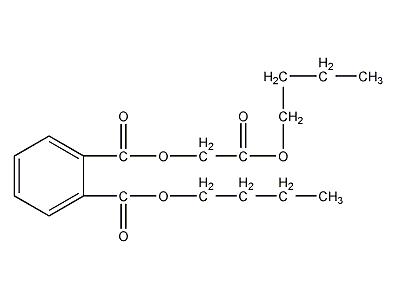
Structural formula
| Business number | 01W5 |
|---|---|
| Molecular formula | C18H24O6 |
| Molecular weight | 336.38 |
| label |
Butyl Phthalyl Glycolate, Butyl glycolate butyl phthalate, Butoxycarbonylmethylbutyl peptidate, Butylphthaloylglycerol butyl ester, Butoxycarbonyl methylbutyl ester peptides, Functional Materials, Plasticizer |
Numbering system
CAS number:85-70-1
MDL number:MFCD00053793
EINECS number:201-624-8
RTECS number:TI0535000
BRN number:None
PubChem ID:None
Physical property data
1. Physical property data
1. Properties: Almost colorless oily liquid
2. Density (g/mL, 25/4℃): 1.1
3. Relative vapor density (g/mL, air=1): Uncertain
4. Melting point (ºC): Uncertain
5. Boiling point (ºC, normal Pressure): 220 °C (10 mmHg)
6. Boiling point (ºC, 5.2kPa): Uncertain
7. Refractive index: 1.490 (25℃)
8. Flash point (ºC): 199 °C (open cup)
9. Specific rotation (º): Uncertain
10. Autoignition point or ignition Temperature (ºC): Uncertain
11. Vapor pressure (kPa, 25ºC): Uncertain
12. Saturated vapor pressure (kPa, 60ºC): Uncertain
13. Heat of combustion (KJ/mol): Uncertain
14. Critical temperature (ºC): Uncertain
15. Critical pressure (KPa): Uncertain
16. The logarithmic value of the oil-water (octanol/water) partition coefficient: Uncertain
17. The upper limit of explosion (%, V/V): Uncertain
18. Lower explosion limit (%, V/V): Uncertain
19. Solubility: Miscible with castor oil, linseed oil, and Chinese tung oil. 20. Freezing point (ºC): -3521. Viscosity: 51mPa·s
Toxicological data
1. Acute toxicity:
Rat caliber LD50: 7mg/kg; rat abdominal cavity LD50: 6889 uL/kg;
Mouse caliber LD50: 12567mg/kg; Mouse abdominal LD50: 6880mg/kg;
2. Neurotoxicity:
Rabbit eye test: 20 mg/24HREACTION;
3. Reproductive toxicity;
Rat abdominal TDL0: 2296mg/kgSEX/DURATION, death; rat abdominal TDL0: 689mg/kgSEX/DURATION, malformation;
4. Teratogenicity
Hamster fibroblasts: 125mg/L/24H
Ecological data
None yet
Molecular structure data
5. Molecular property data:
1. Molar refractive index: 88.63
2. Molar volume (cm3/mol): 300.7
3. Isotonic specific volume (90.2K): 759.9
4. Surface tension ( dyne/cm): 40.7
5. Polarizability (10-24cm3): 35.13
Compute chemical data
1. Reference value for hydrophobic parameter calculation (XlogP): None
2. Number of hydrogen bond donors: 0
3. Number of hydrogen bond acceptors: 6
4. Number of rotatable chemical bonds: 13
5. Number of tautomers: none
6. Topological molecule polar surface area 78.9
7. Number of heavy atoms: 24
8. Surface charge: 0
9. Complexity: 406
10. Number of isotope atoms: 0
11. Determine the number of atomic stereocenters: 0
12. Uncertain number of atomic stereocenters: 0
13. Determine the number of chemical bond stereocenters: 0
14. Number of uncertain chemical bond stereocenters: 0
15. Number of covalent bond units: 1
Properties and stability
It is miscible with castor oil, linseed oil, and Chinese copper oil, and is compatible with most resins. It has good light resistance, alkali resistance, cold resistance, non-toxic and odorless.
Storage method
Should be stored in a ventilated and dry place indoors, away from sources of fire. Store and transport according to regulations on flammable chemicals.
Synthesis method
(1) Put phthalic anhydride and butanol into the reaction kettle at a molar ratio of 1:1.05, stir and raise the temperature to about 100°C for monoesterification to generate monobutyl phthalate.

(2 ) Put chloroacetic acid and butanol into the reaction kettle at a molar ratio of 1:1.2, stir and raise the temperature to (140±5)°C for reaction to generate butyl chloroacetate.

(3 ) Put the monobutyl phthalate, butyl chloroacetate and sodium carbonate prepared above into the reaction kettle in a molar ratio of 1:1.1:0.6, and raise the temperature to 150°C with stirring to perform condensation. The crude product is washed with water at 60-70°C, and then washed with 10% soda ash. After washing with water, add thin film for evaporation. Then use activated carbon with a mass of about 2% of the mass of butyl ester to decolorize at 80-90°C, and finally press filter to obtain the finished product.

Purpose
1. This product is used as a plasticizer for polyvinyl chloride, polystyrene, acrylic resin and alkyd resin, the dosage is 5% to 10%; it is used as a plasticizer for phenol resin, polyvinyl acetate and butyl cellulose acetate. As a plasticizer, the dosage is about 30%; as a plasticizer for propylene cellulose acetate, polyvinyl acetal, and chlorinated rubber, the dosage is 10% to 25%. It can give products excellent softness, weather resistance and elasticity. This product is tasteless, non-toxic, odorless, oil- and solvent-resistant and has good extraction resistance. It is especially suitable for making food packaging and medical infusion tubes and infusion bags. It can give products excellent softness, weather resistance and elasticity, and is especially suitable for making food packaging and medical infusion tubes and infusion bags.

 微信扫一扫打赏
微信扫一扫打赏

